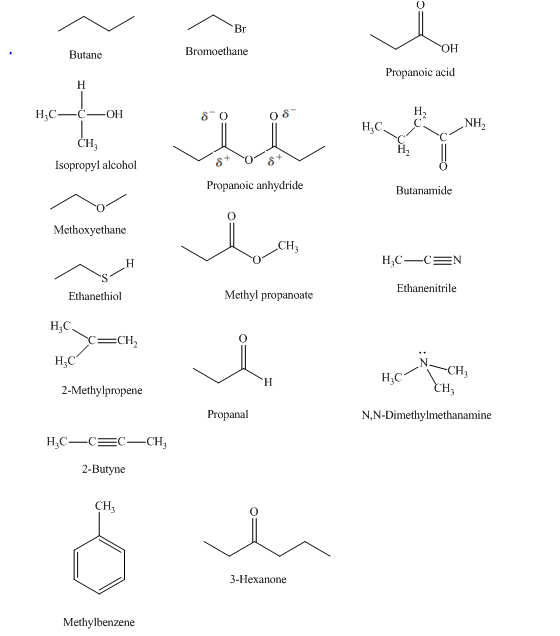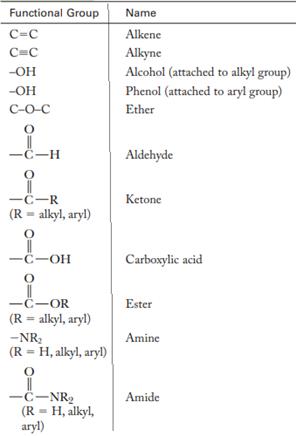
Organic Chemistry: Structure and Function
8th Edition
ISBN: 9781319079451
Author: K. Peter C. Vollhardt, Neil E. Schore
Publisher: W. H. Freeman
expand_more
expand_more
format_list_bulleted
Concept explainers
Question
Chapter 2, Problem 37P
Interpretation Introduction
Interpretation: All polarized covalent bonds present in

Concept introduction: A functional group is defined as an atom or group of certain atoms that confer reactivity to the overall organic compound. They undergo specific reactions. Majority of functional groups are polarized in nature. The presence of functional groups controls the reactivity of organic moiety as a whole.
The major functional groups are given as follows:

Expert Solution & Answer
Want to see the full answer?
Check out a sample textbook solution
Students have asked these similar questions
Compare columns I and II, and write
A if the value in columnl is greater than in II
B if the value in column Il is greater than in I
Cif both values are equal
D if the value in column I cannot be compared with that in II
C-O bond length
Column I
Column II
cyclohexanol
cyclohexenol
The curved arrow notation introduced in Section 1.6B is a powerful method used by organic chemists to show the movement of electrons not only in resonance structures, but also in chemical reactions.Because each curved arrow shows the movement of two electrons, following the curved arrows illustrates what bonds are broken and formed in a reaction. Consider the following three-step process. (a) Add curved arrows in Step [1] to show the movement of electrons. (b) Use the curved arrows drawn in Step [2] to identify the structure of X. X is converted in Step [3] to phenol and HCl.
The curved arrow notation introduced in Section 1.6 is a powerful method used by organic chemists to show the movement of electrons not only in resonance structures, but also in chemical reactions. Since each curved arrow shows the movement of two electrons, following the curved arrows illustrates what bonds are broken and formed in a reaction. Consider the following three-step process. (a) Add curved arrows in Step [1] to show the movement of electrons. (b) Use the curved arrows drawn in Step [2] to identify the structure of X. X is converted in Step [3] to phenol and HCl.
Chapter 2 Solutions
Organic Chemistry: Structure and Function
Ch. 2.1 - Prob. 2.1ECh. 2.1 - Prob. 2.2ECh. 2.1 - Prob. 2.3ECh. 2.1 - Prob. 2.5TIYCh. 2.1 - Prob. 2.6ECh. 2.1 - Prob. 2.7ECh. 2.2 - Prob. 2.8ECh. 2.3 - Prob. 2.9ECh. 2.3 - Prob. 2.10ECh. 2.3 - Prob. 2.11E
Ch. 2.3 - Prob. 2.12ECh. 2.3 - Prob. 2.13ECh. 2.3 - Prob. 2.14ECh. 2.3 - Prob. 2.15ECh. 2.3 - Prob. 2.17TIYCh. 2.3 - Prob. 2.19TIYCh. 2.5 - Prob. 2.20ECh. 2.6 - Prob. 2.21ECh. 2.6 - Prob. 2.22ECh. 2.6 - Prob. 2.23ECh. 2.6 - Prob. 2.25TIYCh. 2.7 - Prob. 2.26ECh. 2.9 - Prob. 2.28TIYCh. 2 - Prob. 31PCh. 2 - Prob. 32PCh. 2 - Prob. 33PCh. 2 - Prob. 34PCh. 2 - Prob. 35PCh. 2 - Prob. 36PCh. 2 - Prob. 37PCh. 2 - Prob. 38PCh. 2 - Prob. 39PCh. 2 - Prob. 40PCh. 2 - Prob. 41PCh. 2 - Prob. 42PCh. 2 - Prob. 43PCh. 2 - Prob. 44PCh. 2 - Prob. 45PCh. 2 - Prob. 46PCh. 2 - Prob. 47PCh. 2 - Prob. 48PCh. 2 - Prob. 49PCh. 2 - Prob. 50PCh. 2 - Prob. 51PCh. 2 - Prob. 52PCh. 2 - Prob. 53PCh. 2 - Prob. 54PCh. 2 - Prob. 55PCh. 2 - Prob. 56PCh. 2 - Prob. 57PCh. 2 - Prob. 58PCh. 2 - Prob. 59PCh. 2 - Prob. 60PCh. 2 - Prob. 61PCh. 2 - Prob. 62PCh. 2 - Prob. 63PCh. 2 - Prob. 64PCh. 2 - Prob. 65PCh. 2 - Prob. 66P
Knowledge Booster
Learn more about
Need a deep-dive on the concept behind this application? Look no further. Learn more about this topic, chemistry and related others by exploring similar questions and additional content below.Similar questions
- An electrostatic potential map of calicene is shown below. a) Both the electrostatic potential map and its significant dipole moment indicate that calicene is an unusually polar hydrocarbon. Which of the dipolar resonance forms, structure A or structure B, better corresponds to the electron distribution in the molecule? Select the single best answer. b) Which one of the following structures should be stabilized by resonance to a greater extent? Select the single best answer.arrow_forwardAssign the correct formal charge to the oxygen atom in this structure (you may right click on the atom and use the Charge menu, or use the + and - buttons on the graphical toolbar). Once the correct formal charges have been placed, identify all atoms with a reasonable formal charge by setting the map number to 1, and those with an unreasonably large formal charge by setting the map number to 2. HINT: all of the hydrogen atoms are already shown.arrow_forwardMake a continuous model for C4H10 by using 4 black 4 hole carbon atoms, 10 white one hole hydrogen atoms, and 13 pink bonds. Then write in wedge dash notation C4H10 and add in missing hydrogen atoms.arrow_forward
- Write an equation for the reaction of CH3 SCH3 with BF3, a Lewis acid, and show by the use of curved arrows how the reaction occurs. • Show all hydrogen atoms that are not attached to a carbon atom. Apply formal charges where appropriate. Assign lone pairs and radical electrons where appropriate. • Use the "starting points" menu to revert to the original molecule(s) shown. • Draw the appropriate electron-flow arrows. • Omit+ signs between structures. ● ● CH3 | :S: | CH3 == starting points == ↑ TAYY : F کر ? ChemDoodleⓇarrow_forwardIn the following Lewis structure of [(CH3)2OH]*, every atom, bond and lone pair is positioned. To complete the structure, drag the formal charge tags to the appropriate atom(s). Each marker may be used more than once, or not at all. If an atom has a formal charge of zero, do not drag a tag to it. When you drag the marker in, place the little crosshairs in the upper left corner of the marker directly over the atom(s) in question (not above them). H. H-C Н-С-О-С-Н C-H H HH 2- II 2-arrow_forward6. (a) In structure 3 of Model 2, the double bond electrons move to form a lone pair on oxygen. The arrow below shows the double bond electrons moving to form a lone pair on carbon. Draw the resulting resonance form (make sure to put in charges). HC :O: CH₂ 3 (b) Although this form is possible, it is not likely. As a group, discuss why the lone pair is more likely to reside on oxygen than on carbon. 7. Follow the resonance structure guidelines developed in question #4 above. For each pair below, determine whether the resonance structure on the right is an acceptable resonance structure of the form on the left. Place an X through any incorrect structures on the right of each pair, and indicate which of the items listed in question 4 were not followed. Once everyone in your group agrees, draw a correct resonance form. :0 [R-1 H H 4 H H CH₂ CH₂ |- N POGIL www.FOOIL.ORGarrow_forward
- 8. If a resonance structure must have a negative formal charge, that charge is most stable on an electronegative atom. Draw all relevant resonance structures of the molecule below with curved arrows only using pattern 1. Circle the most stable structure(s). Explain the choice of most stable structure with 1-3 complete sentences.arrow_forward4. Circle the following pairs of structures that do not constitute resonance structures. For the proper resonance pairs, draw curved arrows to convert the first structure to the second. Draw in all lone pairs of electrons. H3C-CH3 „CH3 HgC-N' a) b) H2C=C=CH2 H3C-CECH FCH2 d) H3C' CH2 H H3Carrow_forwardHere is the chemical structure of 2-bromobutane: H H. H C-C-H H :Br: H H Decide whether each molecule in the table below is another molecule of 2-bromobutane, a molecule of an isomer of 2-bromobutane, or a molecule of an entirely different compound. molecule relationship to 2-bromobutane CH, (Choose one) H,c=ċ=CH,-Br Explanation Check O 2021 McGraw Hill LLC. All Rights Reserved. Terms of Use Privacy Center I Accessibility P Type here to search 76°F DELL F1 F2 F3 F4 F5 FB F9 F10 F11 F12 PrtScr PAA @ %23 2$ 1 8. 9 Q W R Y. A F G H. K V N4 Alt Ctri Alt Σ B. C1arrow_forward
- Specify the number of unshared pairs of electrons necessary to complete the valence shell of the labeled atoms, a-c in the following structures. Specify "0" if no pair of electron and that the atoms are NOT labeled in sequence. needs to be added. Notice that formal charges are indicated by or 1. 2. ob d a de C H H H a a b C b ✓Carrow_forwardDraw two additional resonance structures for the following compound. Use curved arrows to show the movement of electrons and draw the resonance hybrid. Note that not all hydrogens and lone pair electrons have been drawn in, it may be helpful to start by drawing those in. Please write your answer on paper and submit it here. If you are not able to submit it here, submit it, along with the other short answer questions, to the "Exam 1 short answer dropbox".arrow_forwardProvide the following names of the following. Answer from left to right.arrow_forward
arrow_back_ios
SEE MORE QUESTIONS
arrow_forward_ios
Recommended textbooks for you
 ChemistryChemistryISBN:9781305957404Author:Steven S. Zumdahl, Susan A. Zumdahl, Donald J. DeCostePublisher:Cengage Learning
ChemistryChemistryISBN:9781305957404Author:Steven S. Zumdahl, Susan A. Zumdahl, Donald J. DeCostePublisher:Cengage Learning ChemistryChemistryISBN:9781259911156Author:Raymond Chang Dr., Jason Overby ProfessorPublisher:McGraw-Hill Education
ChemistryChemistryISBN:9781259911156Author:Raymond Chang Dr., Jason Overby ProfessorPublisher:McGraw-Hill Education Principles of Instrumental AnalysisChemistryISBN:9781305577213Author:Douglas A. Skoog, F. James Holler, Stanley R. CrouchPublisher:Cengage Learning
Principles of Instrumental AnalysisChemistryISBN:9781305577213Author:Douglas A. Skoog, F. James Holler, Stanley R. CrouchPublisher:Cengage Learning Organic ChemistryChemistryISBN:9780078021558Author:Janice Gorzynski Smith Dr.Publisher:McGraw-Hill Education
Organic ChemistryChemistryISBN:9780078021558Author:Janice Gorzynski Smith Dr.Publisher:McGraw-Hill Education Chemistry: Principles and ReactionsChemistryISBN:9781305079373Author:William L. Masterton, Cecile N. HurleyPublisher:Cengage Learning
Chemistry: Principles and ReactionsChemistryISBN:9781305079373Author:William L. Masterton, Cecile N. HurleyPublisher:Cengage Learning Elementary Principles of Chemical Processes, Bind...ChemistryISBN:9781118431221Author:Richard M. Felder, Ronald W. Rousseau, Lisa G. BullardPublisher:WILEY
Elementary Principles of Chemical Processes, Bind...ChemistryISBN:9781118431221Author:Richard M. Felder, Ronald W. Rousseau, Lisa G. BullardPublisher:WILEY

Chemistry
Chemistry
ISBN:9781305957404
Author:Steven S. Zumdahl, Susan A. Zumdahl, Donald J. DeCoste
Publisher:Cengage Learning

Chemistry
Chemistry
ISBN:9781259911156
Author:Raymond Chang Dr., Jason Overby Professor
Publisher:McGraw-Hill Education

Principles of Instrumental Analysis
Chemistry
ISBN:9781305577213
Author:Douglas A. Skoog, F. James Holler, Stanley R. Crouch
Publisher:Cengage Learning

Organic Chemistry
Chemistry
ISBN:9780078021558
Author:Janice Gorzynski Smith Dr.
Publisher:McGraw-Hill Education

Chemistry: Principles and Reactions
Chemistry
ISBN:9781305079373
Author:William L. Masterton, Cecile N. Hurley
Publisher:Cengage Learning

Elementary Principles of Chemical Processes, Bind...
Chemistry
ISBN:9781118431221
Author:Richard M. Felder, Ronald W. Rousseau, Lisa G. Bullard
Publisher:WILEY
Nomenclature: Crash Course Chemistry #44; Author: CrashCourse;https://www.youtube.com/watch?v=U7wavimfNFE;License: Standard YouTube License, CC-BY